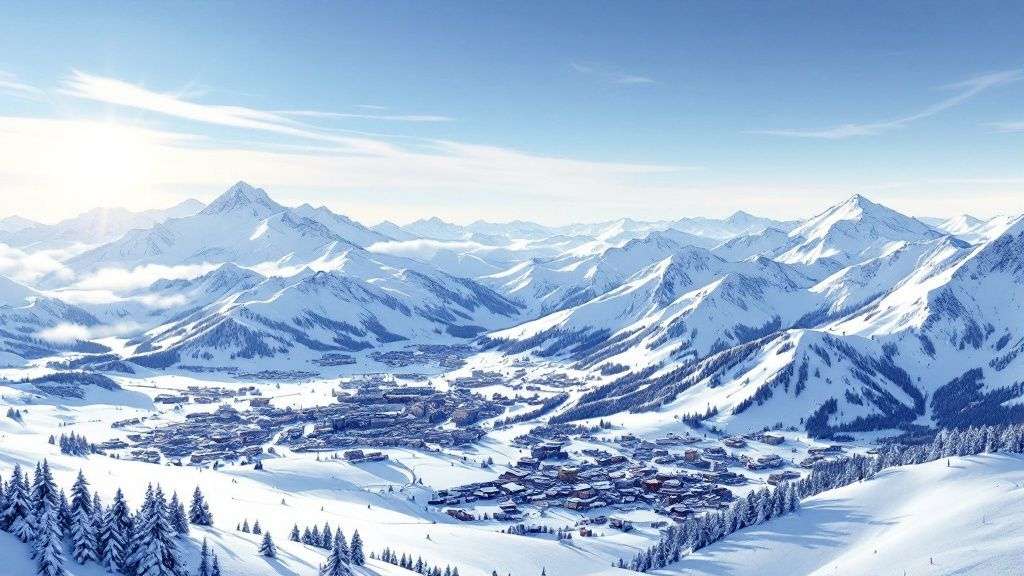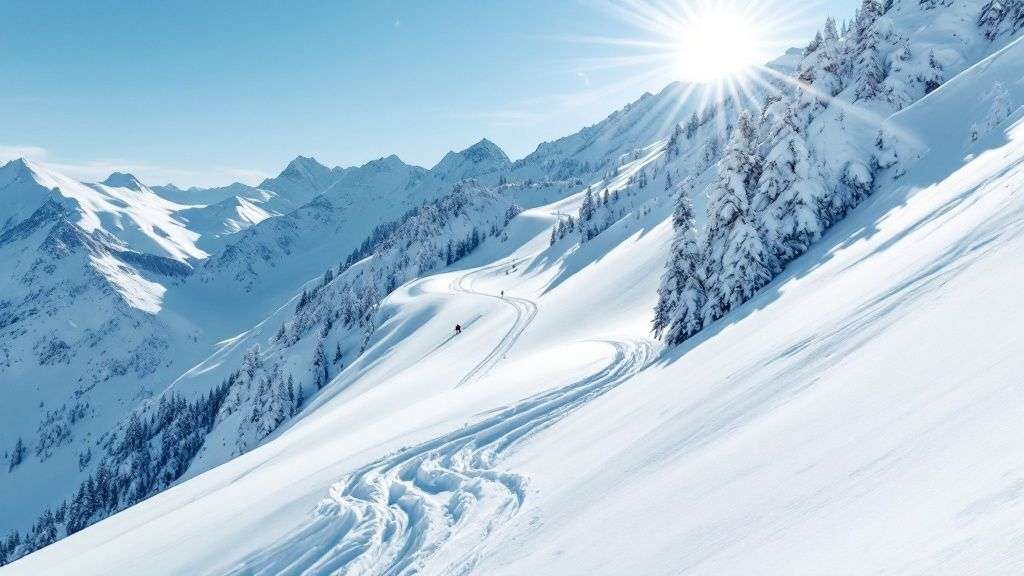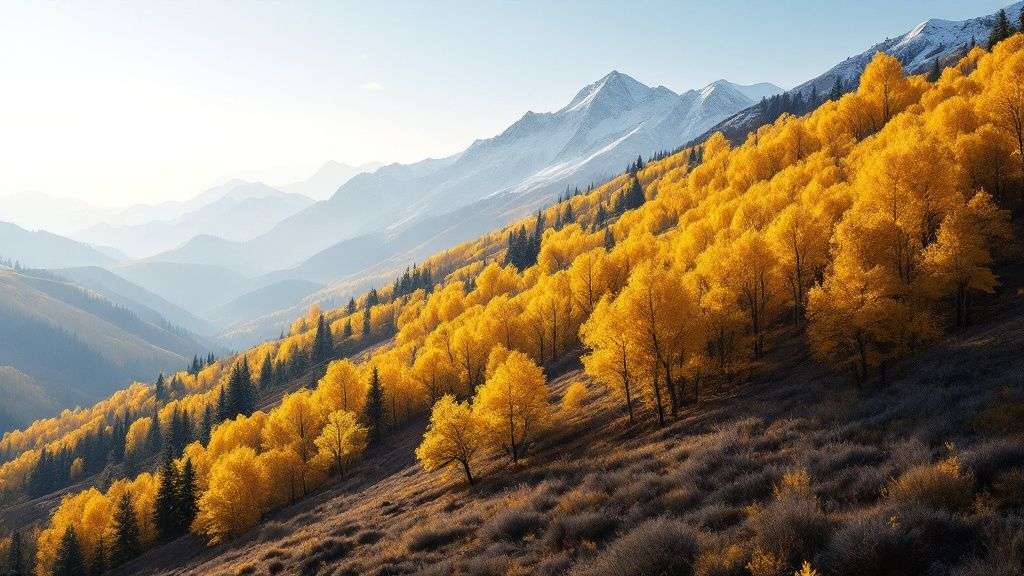Your Guide to Weather at Snowbird Utah
Planning a trip? This guide breaks down the weather at Snowbird Utah, from the legendary lake-effect snow to seasonal patterns and how to check the forecast like a local.
The weather at Snowbird is defined by legendary amounts of light, dry powder snow. Thanks to its prime location deep in Little Cottonwood Canyon, the resort is hammered with over 500 inches of annual snowfall created by lake-effect storms. This guide explains what makes the snow so good and how to plan your trip around the unique mountain conditions.
What creates the weather at Snowbird?
To understand why the snow at Snowbird is so good, you need to know about two key weather phenomena that work in perfect harmony: orographic lift and the lake effect. Together, they are the secret sauce behind "The Greatest Snow on Earth®".

How Orographic Lift Works
Picture a moisture-packed storm rolling in from the Pacific. As it slams into the towering Wasatch Mountains, it has nowhere to go but up. This rapid vertical climb is called orographic lift. As the air rises, it cools and gets squeezed, forcing moisture to fall as intense, concentrated snow over the peaks of Little Cottonwood Canyon. This is why Snowbird gets buried while Salt Lake City, just miles away, might only see a dusting.
How the Lake Effect Works
Before storms even reach the mountains, they often get a supercharge. As they pass over the Great Salt Lake, the relatively warm, salty water pumps extra moisture into the atmosphere. This lake effect acts as a turbo-booster, making the resulting snow lighter, drier, and far more plentiful. It’s this one-two punch that creates Utah's famously buoyant, low-density powder that feels like floating.
| Metric | Typical Range / Average |
|---|---|
| Annual Snowfall | 500+ inches (12.7 meters) |
| Average Winter Temp | 12°F to 32°F (-11°C to 0°C) |
| Peak Snowfall Months | December - March |
| Average Snow Density | 8.5% (light and dry) |
| Snow Days / Month | ~10-12 (December - February) |
These numbers tell the story: expect frequent storms, cold temperatures that keep the snow pristine, and a season packed with powder potential. When you're ready to track the next storm, our guide to the Wasatch snow forecast shows you what to look for.
When does Snowbird get the most snow?
Understanding Snowbird's seasonal rhythm is key to planning the perfect trip. The vibe on the mountain changes dramatically from the anticipation of early season to the deep powder of mid-winter and the sun-drenched laps of spring. Knowing what to expect helps you time your visit for your ideal day.

Early Season (November – December)
The early season is all about building the base. Storms begin marching into Little Cottonwood Canyon, laying down the foundation for the winter. Colder temperatures preserve new snow and provide ideal conditions for snowmaking crews to supplement what nature provides. Not all terrain will be open, but it's a great time to find your ski legs without peak-season crowds.
- Average High Temperature: 25°F to 35°F (-4°C to 2°C)
- Conditions: A growing snowpack, frequent but smaller snowfalls, and cold, dry air.
- Local Tip: This is when locals score untracked lines on newly opened terrain.
Peak Winter (January – February)
This is the heart of winter—the two months that forged Snowbird's legendary reputation. The storm track takes dead aim at the Wasatch, delivering the deepest, most consistent powder of the year. The snowpack is at its thickest, opening up the resort's most iconic and challenging terrain. Expect frequent "refills," with storms often dumping feet of snow overnight. This is prime time for powder days, but be ready for storm skiing with lower visibility and colder temperatures.
Spring Skiing (March – April)
As winter gives way to spring, the weather patterns shift. Big storms still hammer the canyon—in fact, March is historically one of Snowbird's snowiest months—but they're often followed by brilliant, sunny days. The higher sun angle warms the snow surface, creating soft "corn" snow in the afternoon. These are classic "bluebird" days: deep blue skies, comfortable temps, and soft, forgiving snow.
The 2023 season was a powerful illustration of this potential, with a historic 838 inches of total snowfall shattering the average. This highlights the area's extreme snow potential and thrilling variability. You can dive deeper into Snowbird's history and its record-setting seasons.
How to check the Snowbird weather forecast
Relying on a generic Salt Lake City forecast is a classic rookie mistake. Mountain weather plays by its own rules, and what's happening in the valley often has no bearing on conditions at 11,000 feet. Here are the data sources locals use to get an accurate picture of the day.
Your Go-To Weather Toolkit
The best approach is to check a few specific sources the morning you plan to ski, as conditions can change in an instant.
- Our Live Snow Report: Start with our snow report for Snowbird Utah, which provides constantly updated, on-the-ground conditions, snowfall totals, and base depth.
- National Weather Service (NWS): Ignore the Salt Lake City forecast. Instead, look for the specific forecast for "Alta/Snowbird" or pull a point forecast for the mountain's elevation. The National Weather Service provides the most reliable data.
- UDOT Traffic: Before you leave, always check UDOT Traffic for road status, closures, and traction law requirements in Little Cottonwood Canyon. UDOT LCC Cameras also give you a real-time view of conditions.
How to Read the Forecast
Reading a mountain forecast is an art. Look past the simple icons and learn what key terms mean for your day.
- Snow-to-Liquid Ratio: This tells you about powder quality. A high ratio (15:1 or more) means you're getting light, "champagne" powder. A low ratio points to heavier, wetter snow.
- Wind Loading: Never underestimate the wind. Strong winds scoop up snow and pile it into deep, unstable drifts on leeward slopes, which is a primary driver of avalanche danger.
How to dress for Snowbird weather
Dressing for a day at Snowbird is about building a flexible system that keeps you dry, comfortable, and safe as conditions shift. The secret is mastering the art of layering, which lets you adapt to anything from a windy morning to a bluebird afternoon.

The Three-Layer System
- Base Layer: Sits against your skin to pull moisture away from your body. Choose wicking materials like merino wool or synthetics. Avoid cotton, which absorbs sweat and will make you cold.
- Mid-Layer: This is your warmth engine. It traps body heat to insulate you from the cold. Fleece, down, or synthetic puffy jackets are excellent options.
- Outer Layer (Shell): Your armor against wind and snow. This piece must be waterproof and windproof. A good shell keeps the elements out so your other layers can do their job.
Essential Accessories
- Goggles: A good pair with interchangeable lenses is critical. You'll want a low-light lens for storm days and a dark, polarized lens for sunny days to cut intense glare.
- Gloves or Mittens: Insulated, waterproof mittens are always warmer than gloves because they keep your fingers together.
- Sunscreen: UV rays are significantly stronger at high elevation. Apply sunscreen to all exposed skin, even on overcast days, to avoid a nasty burn.
How to travel safely in Little Cottonwood Canyon
The same weather that makes Snowbird legendary also creates its biggest challenge: getting there. Little Cottonwood Canyon (LCC) is one of the most avalanche-prone highways in North America. The Utah Department of Transportation (UDOT) works tirelessly to keep it safe, but this often means road closures for avalanche mitigation.
Driving in the Canyon
When a storm hits, UDOT will put the Traction Law into effect. This is a legal requirement, not a suggestion. To be compliant, your vehicle must have 4WD/AWD with M+S or snow-rated tires, or be a 2WD vehicle with chains or other approved traction devices. For a full breakdown, check our Little Cottonwood Canyon winter driving guide.
In-Resort Safety and Interlodge
The safety mindset continues once you've parked. Always respect rope lines and terrain closures implemented by ski patrol for avalanche control. During extreme avalanche danger, the resort may go into Interlodge, a safety protocol requiring everyone to stay indoors while avalanche work happens on the mountain and road.
FAQ: Snowbird Weather

What month has the best snow at Snowbird?
While you can score an epic day anytime from December to April, the sweet spot is usually January and February. This is when the storm cycle is most active, and consistently cold temperatures keep the snow light, dry, and deep, opening up the resort's legendary steep terrain.
How accurate are weather forecasts for Snowbird?
Mountain weather is notoriously fickle. Forecasts for high-elevation places like Snowbird are a solid starting point, but never a guarantee. Conditions in Little Cottonwood Canyon can shift from bluebird to blizzard in minutes. Your best bet is to check a trusted forecast the morning you ski and always come prepared for changing conditions by dressing in layers.
Do I need a 4WD vehicle to get to Snowbird?
During and after a storm, Utah's traction law is almost always in effect for Little Cottonwood Canyon. This law mandates that all vehicles must have either 4WD/AWD with proper M+S or 3-Peak Mountain Snowflake tires, or be a 2WD vehicle with chains installed. Before you head up the canyon, always check the latest road status from UDOT.